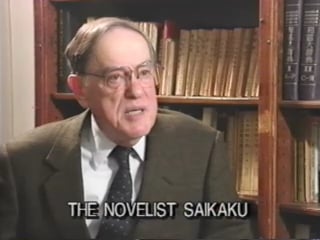Playlist: Tokugawa Japan: Saikaku (1642-1693) – The Comic Novelist
The Comic Novelist
(Ihara Saikaku is referred to by his given name, Saikaku, which is the custom with certain Japanese writers. In most cases, however, Japanese writers are referenced by their family names.)
Transcript
Donald Keene: Saikaku was the first Japanese novelist of any importance for about five hundred years. And one of the very few whose name is even known. For a long period, under the influence of Buddhism, it was felt that writing fiction was a bad thing. That it was a lie, talking about people that never lived as if they really had lived was a sin. And it was even a tradition during the Middle Ages that Lady Murasaki, the author of the Tale of Genji, was punished in hell for having described people who didn't exist. That she was punished for this terrible sin of lying to people about things that had never happened. But, we are now in a different age, where people are excited about the present, what's going on in the world, and the emblematic novelist is Saikaku, whose books are called ukiyo-zoshi or tales of the floating world.
His stories are almost all about contemporaries. Some of the people mentioned in the works are all people who actually lived and known to everybody. Some of them had happy lives, some of them were tragic. But he was completely unsentimental about them. Chikamatsu in his plays obviously wanted to move audiences, make them feel that there was tragedy even in very ordinary lives. Saikaku found the comic quality in these same lives. People who made all kinds of extravagant protestations of love might change their minds the next time they saw a pretty face. This sort of irony is a typical element in Saikaku's writings.
[Excerpt from "What the Seasons Brought the Almanac Maker"in Five Women Who Loved Love]
There was in the capital a band of four inseparable young men who were known for their handsome appearance and riotous living... After the theater one evening... they decided to watch for pretty girls among the people who had gone to see the wisteria blossoms and were now returning to their homes. After a worldly actor in the group had been chosen as chief judge, a beauty contest was conducted until the twilight hours... At first they were disappointed to see some maids riding in a carriage, which hid them from sight. Then a group of girls strolled by in a rollicking mood – 'not bad, not bad at all' – but none of the girls quite satisfied their exacting standards. Paper and ink had been brought to record their entries, and it was agreed that only the best should be put on their list. Next they spied a lady of thirty-four or thirty-five with a graceful long neck and intelligent-looking eyes... Underneath she wore white satin, over that light blue satin, and outside – reddish-yellow satin... Assuredly this was a woman of exquisite taste... Around her head she had draped a veil like that worn by court ladies; she wore stockings of pale silk and sandals with triple braided straps. She walked noiselessly and gracefully, moving her hips with a natural rhythm. 'What a prize for some lucky fellow!' a young buck exclaimed! But these words were hardly uttered when the lady, speaking to an attendant, opened her mouth and disclosed that one of her lower teeth was missing, to the complete disillusionment of her admirers.
Donald Keene: Saikaku today is considered one of the important Japanese novelists. At the end of the nineteenth century, after a period when the Japanese were very rapidly assimilating European literature and forgetting their traditions, it was the rediscovery of Saikaku by several authors which brought to the attention of Japanese writers that they had something to build on in their own tradition of the novel.
Saikaku is an important writer, but is a writer who is enjoyable to read, fun to read, because of his sense of humor. A comic novelist is always as important as a tragic novelist, I believe.
Excerpt from Donald Keene, Anthology of Japanese Literature from the Earliest Era to the Mid-Nineteenth Century, pp. 336-337
About the Speaker
Donald Keene, University Professor Emeritus; Shincho Professor Emeritus of Japanese Literature
Columbia University
Related Videos
Tokugawa Japan: Bashō (1644-1694) – Master of The Haikai and Haiku Forms
Tokugawa Japan: Bashō Narrow Road to The Deep North
Introduction to Tokugawa Japan
Tokugawa Japan: Saikaku (1642-1693) – The Comic Novelist


